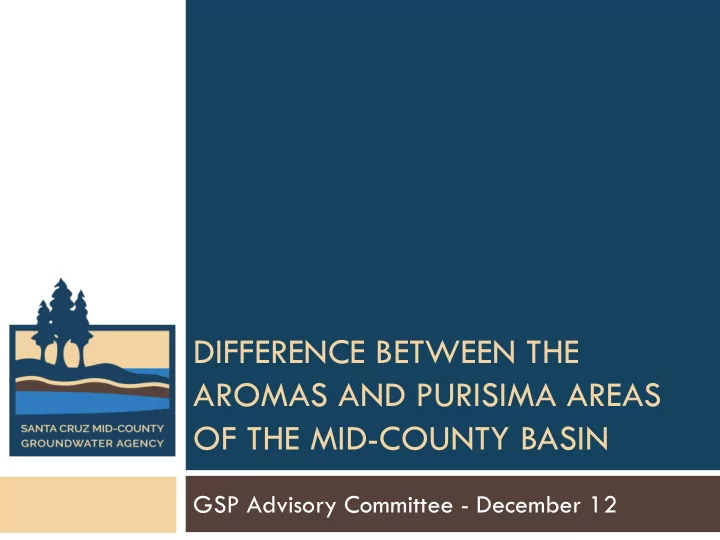

DIFFERENCE BETWEEN THE AROMAS AND PURISIMA AREAS OF THE MID-COUNTY BASIN GSP Advisory Committee - December 12
Aromas and Purisima Differences Hydrogeologic Groundwater quality Connected surface water Sensitivity to pumping Implications for the GSP
Hydrogeologic Differences
Aromas Area is the Aromas Red Sands Outcrop and underlying Purisima F- Unit Municipal wells often screened in both Aromas Red Sands and Purisima F unit
Greater vertical gradient Greater vertical gradient Small gradient Purisima Area Aromas Area Leakage from Aromas Red Sands into Purisima F unit - hydrogeologically more similar Limited leakage in deeper Purisima units because of aquitards
Groundwater Quality Differences
Natural Groundwater Quality Purisima Formation Chloride: 10 - 100 mg/L TDS: 270 - 740 mg/L Basin generally has Iron: up to 3,000 µg/L Aromas Area arsenic < 1 µg/L Manganese: up to 600 µg/L Chloride: 8 - 58 mg/L TDS: 95 - 470 mg/L Chromium VI: 5-40 µg/L Arsenic up to 5.5 µg/L Drinking Water Stds Chloride = 250 mg/L (S) TDS = 1,000 mg/L (S) Iron = 300 µg/L (S) Seawater Intrusion Mn = 50 µg/L (S) Arsenic = 10 µg/L (P) Total Chromium = 50 µg/L (P)
Land Use Effects on Groundwater Quality Purisima Area Nitrate as N: mostly non-detect < 0.0025 mg/L Primary drinking water standard = 10 mg/L Aromas Area Nitrate as N: ~4 mg/L Perchlorate: < 0.8 µg/L MTBE < MCL of 13 µg/L (MCL = 6 µg/L) 1,2,3 TCP >MCL of 5 ppt Aromas area more v. low levels susceptible to of CECs contamination from Nitrate N > surface sources 10 mg/L Improve management of overlying land uses
Connected Surface Water Differences
Greater depth to groundwater below creeks in Aromas area results in less connection to surface water More connection in Purisima units Aromas area < 5% connection Groundwater > 100 ft below creeks
Conceptual Diagram Aromas Red Sands & Purisima F • More permeable • Faster movement of groundwater • No aquitards to limit infiltration Purisima F creek creek Deeper Shallower Aromas water water table table Deeper Purisima units • Less permeable • Slow movement of groundwater • Aquitards between aquifers limit infiltration • Groundwater table mimics topography
Sensitivity to Pumping
Recent Sensitivity Runs Coastal Aromas/Purisima F municipal wells Coastal Aromas/Purisima F non-municipal wells Pajaro Valley coastal non- municipal wells
Eliminate Coastal Aromas/Purisima F unit municipal pumping • Pumping of 380-830 2 – 4 ft influence Purisima F Purisima F AFY eliminated • 4 SqCWD wells • 2 CWD wells Purisima F No Aromas/PurF muni pumping Redistribute & reduce muni pumping Redistribute muni pumping Aromas Little influence
Eliminate Coastal Aromas/Purisima F unit non-municipal pumping Pumping of 263 AFY 1 ft influence Purisima F Purisima F eliminated • 122 AF ag use • 136 AF institutional use • 5 AF domestic use Purisima F No Aromas/PurF non-muni Basin pumping No Aromas/PurF PV non-muni pumping Redistribute muni pumping Aromas Little influence but greater than municipal
Eliminate Pajaro Valley coastal Aromas/ Purisima F unit non-municipal pumping Pumping of 2,533 AFY little influence Purisima F Purisima F eliminated • 1,774 AF ag use • 611AF institutional use • 148 AF domestic use Purisima F No Aromas/PurF non- muni Basin pumping 0.5 ft influence No Aromas/PurF PV non-muni pumping Redistribute muni pumping Aromas 1.5 ft influence
Pumping Impacts Summary Coastal municipal pumping in the Aromas/Purisima F impacts protective elevations in Purisima F and not much in the Aromas (southernmost well) Coastal non-municipal pumping in the Aromas/Purisima F impacts protective elevations in Purisima F and not much in the Aromas (southernmost well) Coastal Pajaro Valley Aromas pumping impacts protective elevations mostly in the southernmost coastal well (SC-A3A) and has lesser impacts with distance in the Mid- County Basin’s Purisima F wells
Discussion of Differences between the Aromas and Purisima Areas
Implications for the GSP
Implications for the GSP Given there are differences between the Aromas & Purisima areas, are Management Areas needed? Area within a basin for which a GSP may identify different sustainable management criteria, monitoring, or project and management actions based on unique local conditions for water use, water source, geology, aquifer characteristics, or other factors Need to consider: Reason for creation of each management area: do we need to manage certain areas differently to other areas within the Basin? Level of monitoring and analysis: do the different management areas warrant different monitoring and analysis?
Inland Areas with groundwater > 50 feet above sea level • Small influence on coastal groundwater levels • If land use changes, there may be demand for more groundwater in the future
Area of Municipal Production • Most of the Basin’s pumping (muni & institutional) • Vulnerable to seawater intrusion • Likely that projects and management actions will be focused in this area Purisima A Seawater Intrusion Aromas/Purisima F Seawater Intrusion
Aromas Area • Vulnerable to contamination from surface sources • Intruded by seawater Purisima A Seawater Intrusion Aromas/Purisima F Seawater Intrusion
creek creek Alluvial Areas Purisima alluvium • Still to be determined if non-municipal wells have an influence on creek flows
Potential Management Areas ? ?
Discussion
Summary Table of Model Scenarios Eliminate pumping from 6 coastal 1. Aromas/Purisima F unit municipal wells Eliminate pumping from coastal 2. Aromas/Purisima F unit non-municipal wells Eliminate pumping from coastal Pajaro Valley 3. Aromas non-municipal wells
Recommend
More recommend